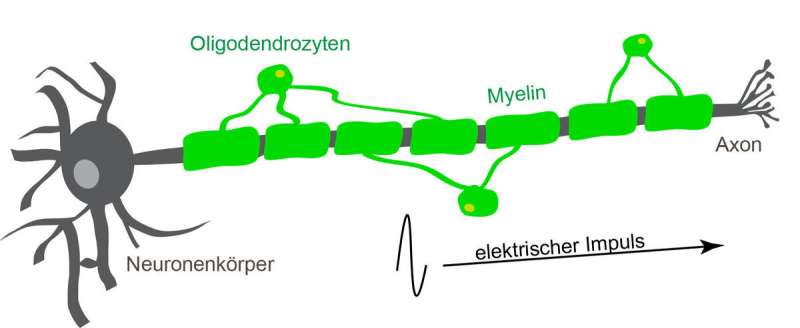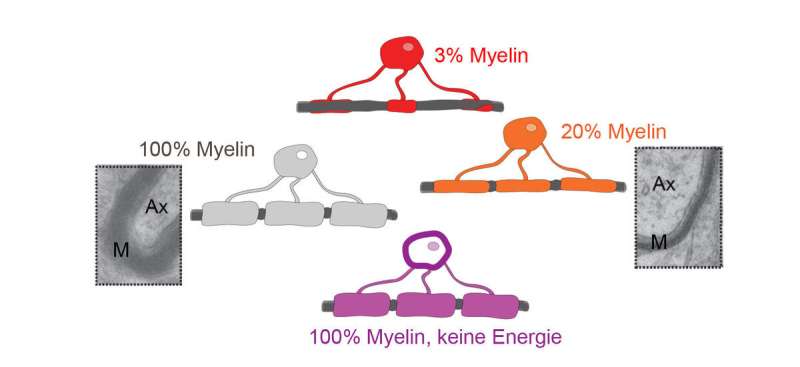Oligodendrocytes wrap around the axon of a nerve cell. In this way, they form an electrical insulation layer around the axon and thus increase the conduction speed. The oligodendrocytes also supply the neuron with energy. Credit: MPI f. Experimental Medicine/ de Hoz, Moore
In a conversation, we can easily understand and distinguish individual words. In the brain, the temporal structure of speech with its rapid succession of sounds and pauses and its characteristic rhythm is encoded by electrical impulses. Researchers at the Max Planck Institute for Experimental Medicine in Göttingen and the Charité - Universitätsmedizin Berlin have discovered that nerve cells can only process the temporal sequence of acoustic signals if they cooperate with certain glial cells.
Nerve cells transmit electrical signals with the help of their axons. The speed and temporal precision required for processing in the brain is only achieved thanks to myelin—an electrical insulation of the axons formed by so-called oligodendrocytes. On the one hand, these glial cells increase the speed of nerve conduction. In addition, the oligodendrocytes supply the nerve cells with energy in the form of lactic acid (lactate).
Little is known about the role of myelin in the processing of sensory perceptions in the cerebral cortex. The researchers have therefore investigated the hearing system, which is specialized in the continuous transmission of information and therefore requires constant energy. To this end, they measured the neuronal activity of the cortex specialized for hearing using animal research in genetically modified mice that produce varying amounts of myelin. "Our results show that less myelin is associated with lower nerve cell activity on repeated acoustic stimuli," says Livia de Hoz, who co-directed the study with Klaus-Armin Nave at the Max Planck Institute for Experimental Medicine.
For their study, the researchers examined genetically modified mice that produce less myelin (red, orange) as normal (grey) as well as mice that produce the same amount of myelin, but in which the myelin does not supply the nerve cells with energy (purple). (Electron microscopic images: Ax: axon, M: myelin). Credit: MPI f. Experimental Medicine/ de Hoz
Deficits in sound processing
The researchers also found that the nerve cells of mice with less or no myelin are less able to identify short pauses within a long-lasting sound. In humans, for example, this ability is an important prerequisite for speech recognition.
The scientists have also supplemented the electrophysiological experiments with learning and behavioral studies. Similar to neuronal activity, it was shown that the genetically modified mice are unable to perceive the pauses embedded in long tones as such. "Myelin is therefore important independently of the actual nerve conduction speed so that nerve cells can correctly decode the temporal sequence of acoustic stimuli," explains Klaus-Armin Nave.
Could this be because oligodendrocytes provide energy to the axons? The researchers have examined a third mouse mutant in which only the energy supply of glial cells to the axons is reduced, but which otherwise has normal myelin levels. Interestingly, these animals show the same deficits in the temporal coding of acoustic signals. "This result makes it very likely that, even with loss of myelin, the reduced energy supply from glial cells is a key factor in the deficits in processing acoustic stimuli," said Sharlen Moore, first author of the study.
More information: Sharlen Moore et al. A role of oligodendrocytes in information processing, Nature Communications (2020). DOI: 10.1038/s41467-020-19152-7
Journal information: Nature Communications
Provided by Max Planck Society

























